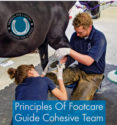Advertise Follow Us
Articles Tagged with ''Laminitis''
The information, ideas and opinions expressed are those of the author and do not necessarily represent those of the United States Department of Agriculture.
Read More
Shoeing For A Living
Principles Of Footcare Guide Cohesive Team
For farrier Travis Burns and the team at Virginia-Maryland College of Veterinary Medicine, successful outcomes rely on each member contributing to a shared goal
Read More
Booknotes: An Unparalled Presentation Of Equine Anatomy
The Illustrated Horse’s Foot (A Comprehensive Guide)
Read More
Farrier Q&A: May/June 2016
What are your criteria for selecting a pad to put on a horse? What type of pad and why?
Read More
Getting To The Bottom Of Toe Cracks
Understanding what causes the problem is critical to correcting it
Read More
Hoof Nutrition Intelligence









